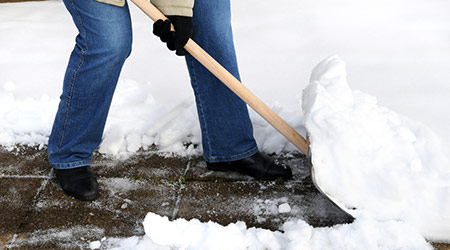Winter weather is upon us, and, as always, it is unpredictable. Importantly, while the weather is out of your control, preparing your building for the elements is not. Healthcare facilities managers must plan ahead and have the right tools and processes in place. It's time to address how to ensure that your healthcare facility will run smoothly and remain safe during these treacherous months.
According to the Bureau of Labor Statistics, there were over forty-two thousand workplace injuries and illnesses involving ice, sleet, or snow that required at least one day away from work to recuperate in 2014. These resulted from “falls, slips or trips; overexertion and bodily reaction; transportation incidents; and contact with objects and equipment.” Among these injuries and illnesses, over 82 percent were due to falls on the same level – essentially, not from heights.
Here are a few tips to help reduce the impact of winter.
Have a communications policy in place
Have procedures and communication plans in place for when road conditions are hazardous. Questions all facilities managers should be able to answer include:
• Does everyone in your building know the policy for staying home in inclement weather?
• If you work in a hospital, what are the emergency weather plans for mandatory staff?
• How and when do employees find out whether the facility is closed during inclement weather?
• What's your telecommuting policy? This includes making sure your staff has the proper equipment to do their job effectively from home. If you already have a telecommuting policy, be sure to remind employees to utilize it during winter.
These are all important questions to consider and address for the safety of your employees and patients.
Prevent slip-and-fall accidents
It is important that those in the healthcare profession are not putting themselves in danger, and that those patients seeking help are not doing further damage from slips and trips. Winter weather can be very slippery, so maintaining your facility's grounds for pedestrians and vehicles is a priority. Find the right device that removes snow and ice from walkways, parking lots, roads and pedestrian pathways without harming surfaces, people or animals. Applying them in advance of storms will reduce risk and improve the safety of those at your facility.
It’s also recommended to have ice melt on hand and ready to go when snow, sleet and freezing rain hits. Entryways and parking lots can get messy and dangerous as people track in ice melt and melting snow. Make sure you have a good cleaning solution that will keep floors safe, along with floor safety signage to warn of hazards. Consider investing in an ice melt spreader for long-term savings, as hand spreading of these materials wastes product and is less effective.
A hot tip for healthcare facilities managers: do your research while it's warm so you know what to purchase before you need it.
Stop the spread of germs
Finally, the winter months bring more than just dangerous driving and walking conditions. Flu season peaks between December and February, and while it would be great if people stayed out of the office when sick, more than half of people who had the flu last year (53%) said they came back to work before they felt better. So what can you do to protect yourself and others in your office? Stock up on antibacterial soap, disinfectant wipes and hand sanitizer and be sure to make them available to everyone, and encourage hand and office space hygiene through signage. And lead by example—if you're sick, stay home!
Remember, it's never too early to start preparing for winter. What steps are you taking to prepare for cold, windy, snowy weather at your workplace?
Riley Quinn Doherty is Area Vice President at Staples Business Advantage, the business-to-business division of Staples, Inc.

 All Eyes on Gen Z as They Enter the Workforce
All Eyes on Gen Z as They Enter the Workforce Cleveland Clinic Starts Fundraising Effort for New Hospital in West Palm Beach
Cleveland Clinic Starts Fundraising Effort for New Hospital in West Palm Beach Cultivating a Workforce in the Face of Skilled Trade Shortages
Cultivating a Workforce in the Face of Skilled Trade Shortages Prime Healthcare Acquires 8 Ascension Hospitals in Illinois
Prime Healthcare Acquires 8 Ascension Hospitals in Illinois Charging Ahead: Incentives Driving EV Charging in Healthcare Facilities
Charging Ahead: Incentives Driving EV Charging in Healthcare Facilities